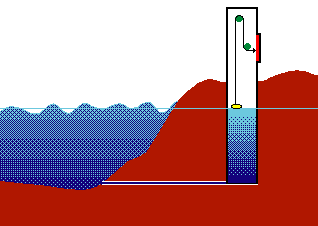 Sketch of a stilling-well tide gauge. The gauge is connected to the sea below the level of the lowest tide via a narrow tube. Rapid fluctuations of sea level produced by (for example) wind waves cannot penetrate this tube because its small diameter does not allow rapid transport of water through it.
Sketch of a stilling-well tide gauge. The gauge is connected to the sea below the level of the lowest tide via a narrow tube. Rapid fluctuations of sea level produced by (for example) wind waves cannot penetrate this tube because its small diameter does not allow rapid transport of water through it.The thin line indicates the sea level after removal of wind waves and other high frequency fluctuations (the "low-passed sea level"). Slow up and down movement of this sea level enters the still well, so the water level in the well is always the same as the low-passed sea level. A float is connected to a recording pen which writes on a rotating drum (red). This produces a sea level record on a paper attached to the drum.
Modern stilling-well gauges use non-mechanical means of measuring the water level in the well (acoustic or laser) and record the data electronically, but the principle remains the same.
contact address: